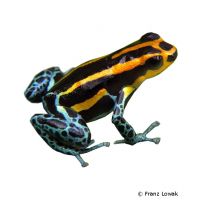Reticulated Poison Frog (Ranitomeya ventrimaculata)
| Reticulated Poison Frog Ranitomeya ventrimaculata | |
|---|---|
| Name | Reticulated Poison Frog |
| Name Lat. | Ranitomeya ventrimaculata |
| Synonym | Dendrobates ventrimaculatus |
| Family | Dendrobatids |
| Family lat. | Dendrobatidae |
| Order | Frogs & Toads |
| Order lat. | Anura |
| Origin | Ecuador, Peru |
| Habitat | Rainforest |
| Diet | Small live insects |
| Humidity | 70-100 % |
| Behavior | Territorial |
| Keeping | Pair |
| Care Level | Difficult |
| Breeding | Moderately difficult |
| Housing | Rainforest terrarium |
| Life Span | 5-10 years |
| Protection | CITES Appendix II; EU Annex B |
| Metric Units | |
| Size | 2 cm |
| Temperature | 25-27 °C |
| Housing Size | 30 x 25 x 35 cm |
| US Units | |
| Size | 0.8" |
| Temperature | 77-81 °F |
| Housing Size | 10" x 10" x 15" |
Distribution and habitat
The diurnal, predominantly ground-dwelling, belly-spotted treecreepers are widespread east of the Andes Mountains of Peru and Ecuador, along the Amazon River basin to its mouth in Brazil, and in French Guiana in tropical rainforests up to about 500 m in elevation. There they live mostly near streams and small water bodies in the foliage covering the ground.
Maintenance
For 1-3 animals, the minimum terrarium area is 750 cm², with a minimum effective height (measured without substrate) of 25 cm. This corresponds to a base area of e.g. 30 x 25 cm. For each additional animal, provide an additional 200 cm² of surface area and 2.5 cm of height. The terrarium should be placed in a quiet place without sunlight.
You need a terrarium with a substrate of loose, absorbent, non-rotting substrate such as sand-peat mixture, coconut fibers or sphagnum moss with a drainage and a shallow, 3-5 cm deep watering place, in addition branched climbing branches, preferably entwined with climbing plants, with horizontal perches, back and side wall coverings of e.g.Tree fern panels (Xaxim) and dense planting (e.g. Tradescantia, Ficus, Scindapsus, ferns, bromeliads). Potted plants that can be easily removed for cleaning are advantageous. At least once a day the inside of the terrarium must be finely sprayed with water (humidity), but a rain or mist system is better
| Temp. day: 25-27 °C | Temp. night: 21-23 °C | Humidity: 70-100 % |
The lighting duration must be 10-14 hours depending on the season. Daylight fluorescent tubes with low UV content are very suitable.
Diet
The food supply consists of live, small insects such as ants, spiders, micro crickets, tiny grasshoppers and crickets, springtails, enchytraea and drosophila. Food should be offered to adults 2-3 times per week, young animals must be fed daily. It is important to add minerals and vitamins regularly (e.g. by dusting the feed animals). The quality of the feed animals can be enhanced by feeding overripe fruit and honey water
A varied diet promotes health and prevents deficiency symptoms.
Reproduction and breeding
The males are a little smaller and slimmer than the females. The spawn, up to 11 eggs, is usually laid hidden in fallen leaves where it is fertilized by the male. The parents engage in brood care, carrying each larva (tadpole) on their backs to a shallow stream or standing pond (bromeliad funnel). After 2-3 months the transformation (metamorphosis) is completed and the frog leaves the water. The breeding of the tadpoles in small plastic boxes filled with water has proven to be successful. They are fed with algae growth, dry fish food and dried mosquito larvae.
Species protection
The animal population must be reported in writing to the responsible authority immediately after the beginning of the keeping. It is essential to find out about any bans on keeping or permits for keeping dangerous animals in your state or municipality (e.g. public order office).
Protection of species: WA Annex II; EU Annex B. The proof of purchase is the required proof of origin for the animal. Please keep it safe! Your pet store will be happy to provide you with further information.
Important
The belly spotted treecreeper is only slightly poisonous. Only in the wild they have a skin toxin, which is absorbed through the food of poisonous insects and converted into the body's own toxin. Therefore they lose their skin poison after some time in terrarium keeping. Afterbreds are non-poisonous.
Prior to purchase, a terrarium should be prepared that meets the species specific needs. Necessary are good ventilation without drafts and equipment for measuring temperature and humidity. The lighting has to correspond to the species-specific day-night rhythm and should be placed in such a way that the animals cannot injure themselves. The terrarium should be locked in such a way that neither unauthorized persons can open it nor the animals can escape. Special attention must be paid to thorough hygiene and impurities must be removed regularly
Further literature can be found in your pet store.
References
Text: petdata; Image: Franz Lowak
Source: ENGELMANN (2006): Zootierhaltung - Tiere in menschlicher Obhut: Reptilien und Amphibien, Harri Deutsch Verlag; VDA & DGHT (2006): Haltungsrichtlinien für die Haltung von Anuren
- Gemäß § 21 Abs. 5 Tierschutzgesetz idgF
